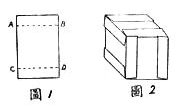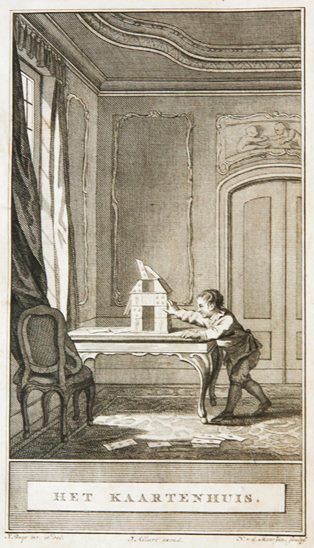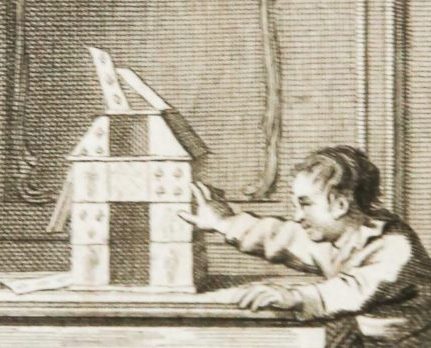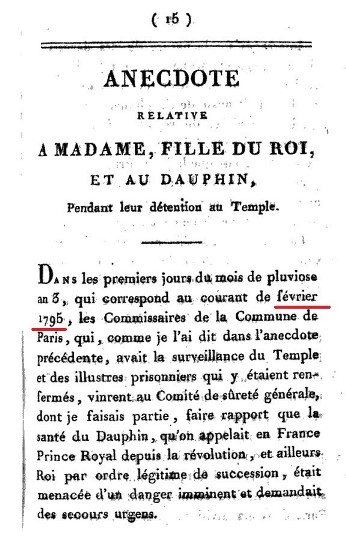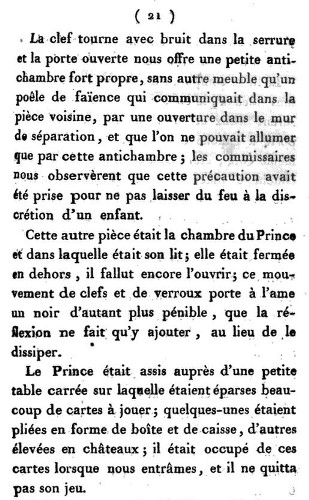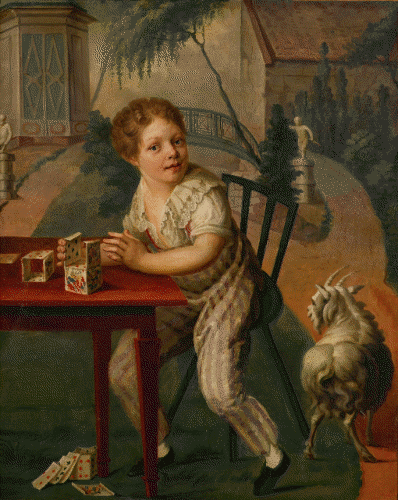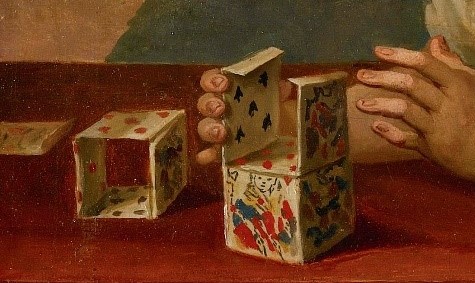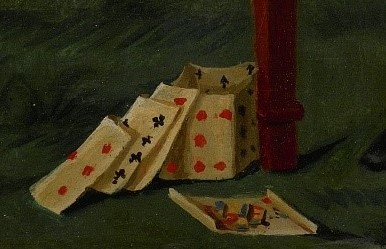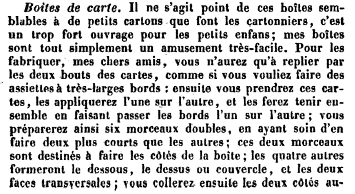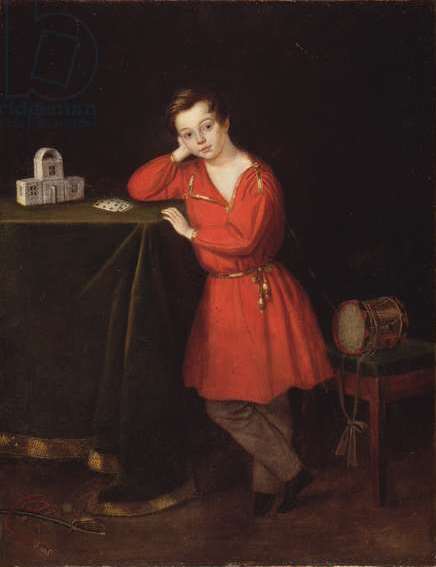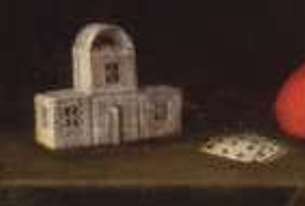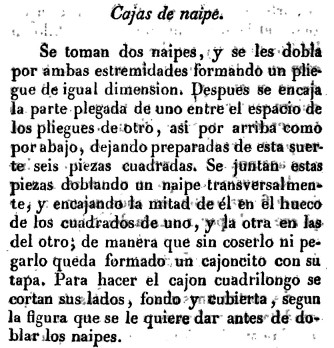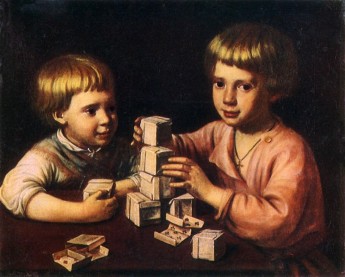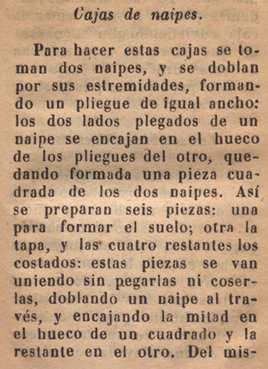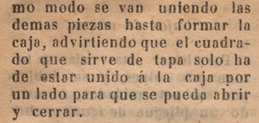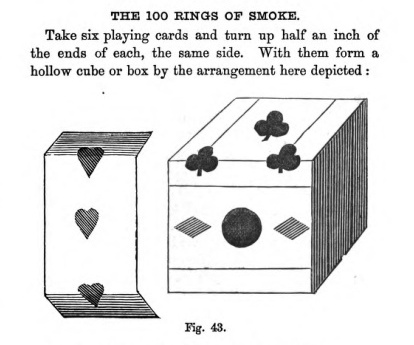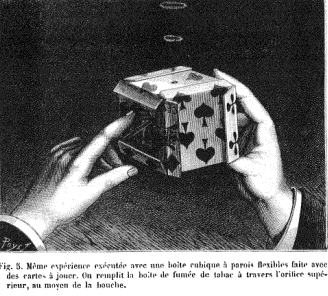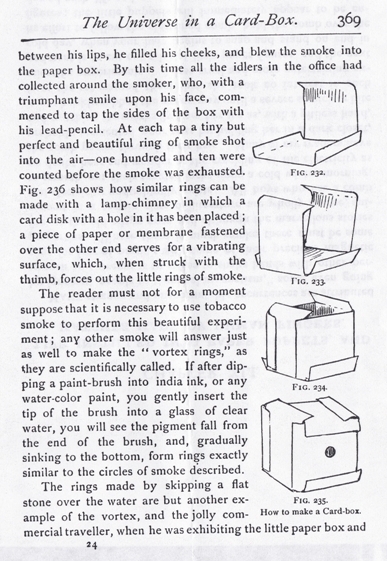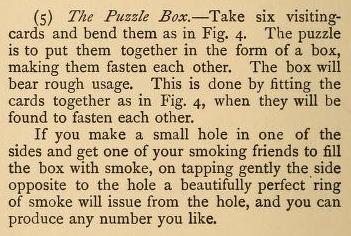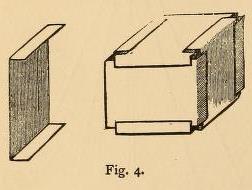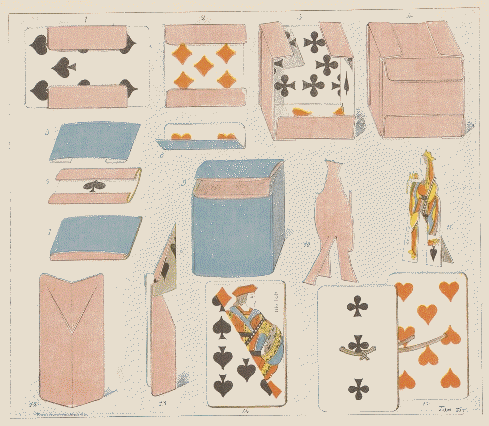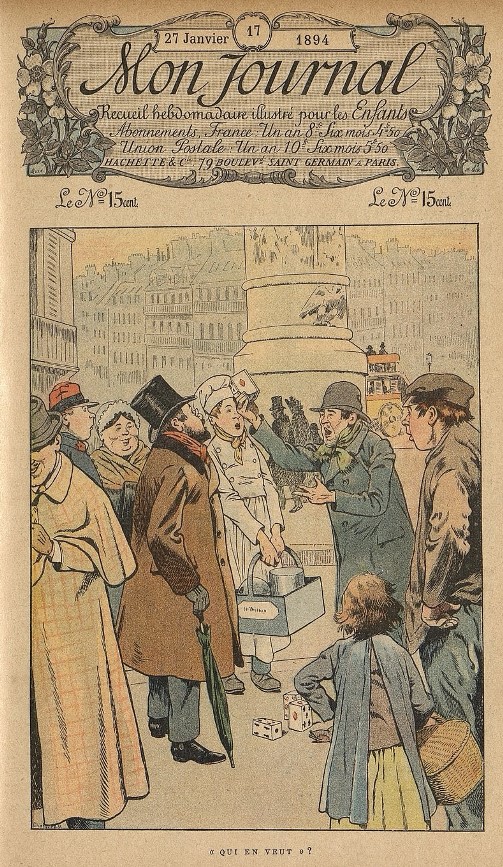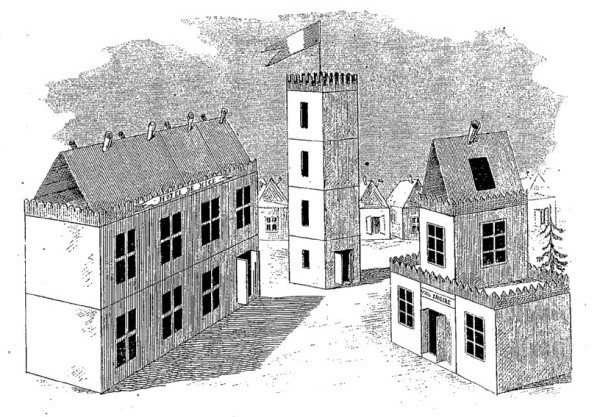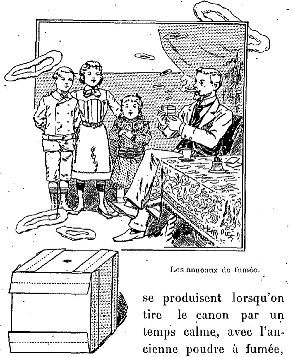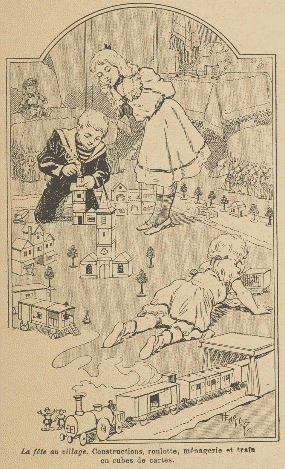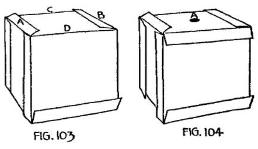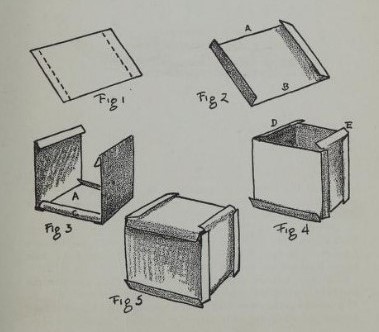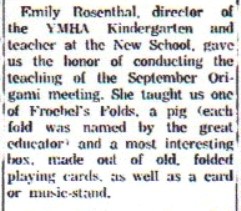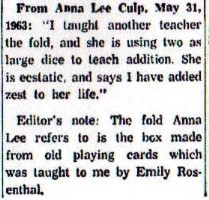| The Public Paperfolding History Project
Last updated 18/12/2025 x |
|||||||
| The Playing Card Cube | |||||||
This page is being used to collect information about the history of the modular origami design known as the Playing Card Cube or, in more modern times, as the Business Card Cube. Please contact me if you know any of this information is incorrect or if you have any other information that should be added. Thank you. ********** In China (and in publications by Chinese authors) 1934 The design appears as 'A Square Box made from Business Cards' in 'Zhezhi Xinfa' (New Ways to Fold Paper), which was published by The Commercial Press in China in 1934.
********** In Europe and the Americas 1759 This print by Jean Baptiste Pillement, published on 26th Dec 1759, shows Chinese children building a House of Cards. It seems to be a Playing Card Cube augmented with a roof made from two other cards. (Compare the entry for 1910.) If so, this is a good example of a Western European design being orientalised. ********** 1772 This book illustration is taken from C.F. Gellert's 'Fabelen en Vertelsels' (Fables and Tales), published in 1772. It shows a Kaartenhuis, the lower levels of which appear to be made of seven Playing Card Cubes. There are, however, no flaps in view (as there would be with Playing Card Cubes - unless they have been clad with additional cards) and all the cards seem to be arranged in the same direction. The construction of the roof also seems suspect. However, the child in the picture is clearly about to push the structure over and the poem that accompanies the illustration in the book makes reference to the house being destroyed and rebuilt repeatedly, which would not be possible if the cards were glued together. On balance, therefore, it is likely that this is intended to be a representation of a Card Castle built using Playing Card Cubes, although a representation that was probably drawn from memory / imagination rather than from life.
********** 1795 There is mention of the young and imprisoned Louis XVII of France building playing cards into 'cubes and crates' in 'Anecdotes relatives à quelques personnes et à plusieurs événements remarquables de la Révolution' (Anecdotes relating to some people and to several remarkable events of the Revolution) by Jean-Baptiste Harmand, published in 1814. Information from Michel Grand.
In English the relevant sections translate as: Page 16: 'In ... February 1795 the Commissaires of the Commune of Paris, who as I said in the previous anecdote, had the surveillance of the Temple and the illustrious prisoners who were locked up there, came to the Committee of General Safety, of which I was a member, (for a) report that the health of the Dauphin, who in France was called Prince Royal since the Revolution, and elsewhere King by legitimate order of succession, was threatened with imminent danger and called for urgent help.' Page 21 bottom: 'The Prince was seated near a small square table on which were scattered many playing cards; some were folded in the form of a box and a crate, others built into castles; he was busy with these cards when we entered, and he did not quit his game.' The words 'pliees en forme de boite et de caisse' suggest that the Prince had been making Playing Card Cubes. ********** 1798 This painting, signed L Watteau was advertised for auction by Sotheby's in 2011 as being of the 18th Century French School (so dating prior to 1800). If this is the case, it is the earliest known illustration showing how the cards are joined together. From the signature, the artist is possibly Louis Joseph Watteau (1731 - 1798). If so, 1798 is the last possible date for this painting.
********** 1827 Instructions for making a version of the Playing Card Cube design appear under the heading 'Boites de Carte' in 'Manuel Complet des Jeux de Société' by Elisabeth Celnart, which was published by La Librairie Encyclopedique de Roret in Paris in 1827. This version seems to be intended to be joined together using glue, with the lid attached using a ribbon. Roughly, 'It is not a question of making those small boxes made by cardboard manufacturers, which are too difficult for small children to make; my boxes are quite simply a very easy amusement. To make them, my dear friends, you will only have to fold the two ends of the cards, as if you wanted to make plates with very wide edges. Then you will take these, apply them one on the other, and make them hold together by passing the edges one over the other. You will thus prepare six double pieces, taking care to make two shorter than the others. These two pieces are intended to make the sides of the box. The other four will form the bottom, the top or cover, and the two transverse faces (ie the front and back). You will then glue the two sides to the bottom, which you want to do on a table, then the two other sides opposite each other. You will attach the cover at the end of one of the sides, passing, a few lines from each end, a shovel loop of ribbon, which you will tie a little loose to let the cover play, and you will have a very nice piece of furniture.'
********** c1830 This painting by an unknown artist, but said to be Russian School c1830, shows a boy with a house of cards seemingly constructed from Playing Card Cubes.
********** 1831 'Manual completo de juegos de sociedad o tertulia y la prendas', translated by Frances for D. Mariano de Rementería y Fica, which was published by Palacios in Madrid in 1831, contains a translation of the section about the 'Boites de Carte' which appeared in Celnart (see above).
********** 1837 Playing Card Cubes also appear in this painting, said to date from 1837, by the Ukrainian artist K. Pavlov (1792 - 1852) which is in the possession of the Pskov State United Historical and Architectural Museum.
********** 1847 A written description of how to make a Playing Card Cube appears in 'Juegos de los Ninos', which was published in Madrid by R y Fonseca in 1847. This also appears to have been based on Celnart (see above).
********** Prior to 1852 Part Two of 'Friedrich Froebel's Gesammelte padogogische schriften' (Friedrich Froebel's Collected Educational Writings) edited by Wichard Lange, which was published in two parts in 1862, contains reference to ther making of boxes of various kinds. Froebel does not explain exactly how these cubes are to be made, except that they are from folded paper. From the description it is not impossible that they are Playing Card Cubes, though alternatively they may also be some kind of Cardboard Modelling design.
********** 1872 A version of the Playing Card Cube with a small hole in the centre of the top card that could be used as an apparatus for creating smoke rings appeared in 'Hanky Panky' by W H Cremer, Jun, which was published by John Camden Hotten in London in 1872.
********** 1881 A similar version appeared in 'La Nature' 427 of 6th August 1881 in an article headed 'Sur Les Tourbillons Annulaires Des Liquides et Des Gaz' written by Adrien Guebhard, and subsequently in the third edition of 'Les Recreations Scientifiques' by Gaston Tissandier, which was published in 1883.
********** 1882 Diagrams for the smoke ring producing version were also published, again in 1882, in 'The American Boys Handy Book' by D C Beard, published by Charles Scribner's Sons in New York.
********** 1890 'Exercises Methodiques de Travaux Manuels' by Jean Boogaerts, which was published in Belgium and France in 1890, contains diagrams for the Playing Card Cube as '1er construction de cube' (avec 6 rectangles - cartes a jouer).
As well as the basic construction, the illustrations also show: How to cut the centres from the modules to create an outline cube, and turn this into a lantern
*** How to clad the cube with six other cards
*** How to link the cubes together by interweaving the flaps and how to make ...
*** towers and buildings
*** a curious design called 'broken glasses' which uses mirrors inside the cubes
*** and some complex geometrical forms . *** Clad cubes are also be joined together using strips
********** In 'Half Hours of Scientific Amusement' by Gaston Tissandier, translated by Henry Frith, which was published by Ward, Lock and Co in London, New York and Melbourne in 1890, as 'Whirling Rings' (ie whirling smoke rings).
********** The design also appeared in 'The Boy's Own Book of Indoor Games and Recreations', by G A Hutchinson, was published by the J B Lippincott Company in Philadelphia in 1890 under the title of 'The Puzzle Box'.
********** 1894 'Pour Amuser Les Petits' by Tom Tit, published in Paris in 1894 by E Plon, Nourrit et Cie, contains chapters on how to make toys and amusements for children from, among other things, corks, oranges, nuts, playing cards and cartes de visite. This page shows toys that can be made from playing cards. At the top is the basic Playing Card Cube and below it a derivative Lidded Box made by first putting two cards together to create one side of the box and then linking them togerther with simple joining pieces.
********** The French weekly children's magazine Mon Journal included a story featuring Playing Card Cubes in its issue of 27th January 1894. The pictures are drawn as cuboids but the text and the footnotes make it clear that the magic box is a cube. A hole is cut in the top to facilitate the making of smoke rings.
********** 1895 Articles by Marie Koenig in 'L'Ami de L'Enfance' of 1st July 1895 and 'L'Ami de L'Enfance, 15th July 1895 explain how to construct 'Une rue de Nice a papier' from elements of the Playing Card Cube. These designs are said to have been sent from Nice by the principal of the Rothschild School.
********** 1898 'Travaux Recreatifs Pour les Enfants de 4 a 10 Ans' by Marie Koenig, which was published by Librairie Hachette et cie in Paris in 1898, contains designs for houses developed from the Playing Card Cube. The designs are said to have been sent from Nice by the principal of the Rothschild School. The material used is advertising cards obtained from shops in Nice (which are of similar proportions to playing cards). The chimneys are simply paper cones. ********** 1900 'Construction Work in Cardboard and Paper' by Robert M Smith, which was published by A Flanagan Co in Chicago in 1900, contained the same material relating to the Playing Card Cube that had previously appeared in Boogaerts (see entry for 1890).
********** 1903 The smoke ring version of the design appears in another Tom Tit book, 'La Recreation En Famille' which was published in Paris in 1903 by Librairie Armand Colin.
********** 1906 A third book by Tom Tit, 'Les Bon Jeudis', published in Paris in 1906 by Librairie Vuibert, showed how to link Playing Card Cubes together by means of their external tabs to create designs for modular buildings and trains.
********** 1913 The design appears as 'cubo de naipes con seis rectangulos' in 'Trabajo Manual' by C Champy Alvear, which was published by Cabaut y Cia in Buenos Aires in 1913. The text says that several cubes can be linked together using the external flaps or covered with other cards to create a smooth external surface.
********** 1918 As 'Anillos de humo' in 'Pasatiempos: Fisica Recreativa', which was published by Editorial Muntanola in Barcelona, probably c1918.
********** 1920 Diagrams for both the normal and smoke ring versions appear in 'Paper Magic' by Will Blyth, which was first published by C Arthur Pearson in London in 1920.
********** The design also appears: 1932 As 'A Box of Cards' in 'Winter Nights Entertainments' by R M Abraham, which was first published by Constable and Constable in London in 1932.
********** 1939 As 'A Puzzle Box' in 'Fun with Paper' by Joseph Leeming, which was published by Spencer Press Inc in Chicago in 1939.
********** 1962 'The Origamian' Vol 2: Issue 4 of Autumn 1962 contains mention of an Emily Rosenthal teaching session at which she taught the Playing Card Cube:
********** 1963 As 'Rapid Smoke Rings' in 'Fell's Guide to Papercraft: Tricks, Games and Puzzles' by Walter B Gibson, which was published by Frederick Fell Inc in New York and George McLeod Ltd in Toronto in 1963. The second paragraph of the instructions make it clear that the playing Card Cube is intended here, although you would not be able to infer its shape or construction from the diagrams.
********** Vol 3: Issue 2 of the Origamian for Spring / Summer 1963 also contains a reference to the Playing Card Cube:
********** |
|||||||
